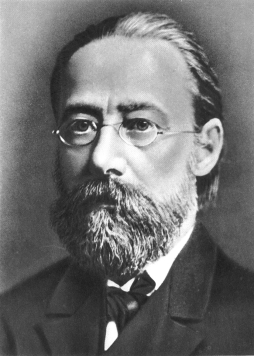Socrates - Comenius 1:
School Project “We are all living under the same sky”
![]()
|
Socrates - Comenius 1: |
|
|
| |
Music
Bedrich Smetana
2. 3. 1824 Litomysl – 12. 5. 1884 Praha
 He
was a Czech famous composer, pianist virtuoso, conductor and together with Antonin Dvorak a founder
of the Czech national music. In 1848 he established his own Musical institute in
Prague. From 1856 to 1861 he taught in Göteborg. From 1861 he was a composer and a
conductor in Prague. After success of his operas The Bartered Bride and The
Brandeburgers in Bohemia, he became a bandmaster of Prozatimni theater. Then he
fell ill with a serious nervous illness and in 1874 he completely turned deaf.
From 1875 he lived in Jabkenice and in 1884 he died in Prague.
He
was a Czech famous composer, pianist virtuoso, conductor and together with Antonin Dvorak a founder
of the Czech national music. In 1848 he established his own Musical institute in
Prague. From 1856 to 1861 he taught in Göteborg. From 1861 he was a composer and a
conductor in Prague. After success of his operas The Bartered Bride and The
Brandeburgers in Bohemia, he became a bandmaster of Prozatimni theater. Then he
fell ill with a serious nervous illness and in 1874 he completely turned deaf.
From 1875 he lived in Jabkenice and in 1884 he died in Prague.
Smetana’s operas
The Brandeburgers in Bohemia
The Bartered Bride - the most famous Czech opera.
Dalibor, Libuse - these two operas are connected with the building of the National theatre.
The Two Widows
The Kiss
Mystery
Devil’s Wall
Viola
Polka
Polka is a favourite musical form of Bedrich Smetana. We can find it in his operas, orchestral or chamber compositions. It is Czech dance of faster pace in 2/4 measure and it arose in 1830 in Hradec Kralove region.
Smetana’s polkas:
Louise‘s polka - written when he was 16 years old
Jirinka’s polka - written when he was 17 years old
From student’s life - written when he was 18 years old
Memory of Pilsen
String quartet From my life - personal work for 4 instruments talking about the composer’s suffering and worries. The second movement of the quartet is quite joyful, in a polka form, describing the joyful atmosphere among countrymen.
The Czech dances - 4 polkas and other 10 Czech antient dances such as Furiant, Slepicka, Oves, Medved, Cibulicka, Dupak, Hulan (in this composition we can find a quotation of a folk song), Obkrocak, Sousedska, Skocna.
In the cycle My Country he assured himself of his ability to compose intensively even after he had become deaf.
The parts of My Country:
Vysehrad - the harps of the prophets start to play, the prophets sing about events in Vysehrad, about glory and battles.
Vltava - the composition portrays the course of the Vltava river, starting with the first 2 tiny streams (the cold and warm Vltava), their joining, the flow of Vltava through fields and woods, through a country where the people are celebrating a feast and finishing on a wide river in Prague.
Sarka - it’s a legend about a young woman.
From the Bohemia’s woods and fields: it’s the impression of the Czech countryside.
Tabor - the structure is built on the glorious hussite song You who are the God’s warriors. The composition encompasses the glory and the praise of hussite struggles.
Blanik - it is continuation of Tabor. After the hussite warriors were defeated, they hid in Mount Blanik and are waiting there, asleep, for the moment, when they will be called to help the country.